
September 15 - December 7, 2014
curated by Christine Shaw
with Abbas Akhavan, Eric Cazdyn, Greig de Peuter, Kanishka Goonewardena, Karen Houle, Mary Lou Lobsinger, Dylan Miner, Paige Sarlin, Scott Sørli, Charles Stankievech, Kika Thorne, cheyanne turions
Opening Reception
Wednesday, September 17, 5–8pm
A FREE shuttle bus will depart from Mercer Union (1286 Bloor Street W.) at 5:30pm and return for 8:30pm.
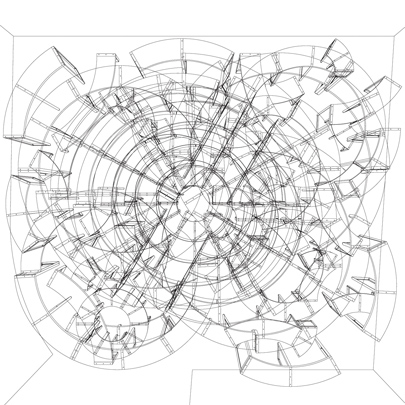

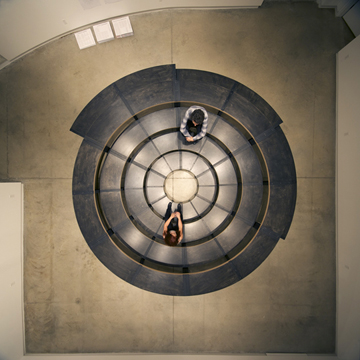
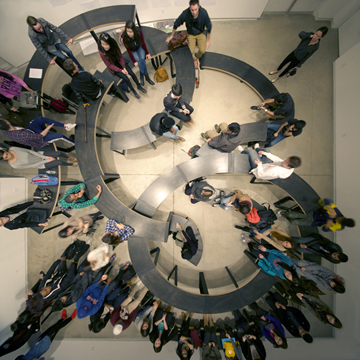

Since the financial crisis of 2008, we have watched a resurgence of political demonstrations and occupations in the Middle East, North Africa, China, Greece, Spain, the United Kingdom, and North America that have reanimated the concept of public space. In each case, citizens gathered in squares and streets, in opposition to today’s political economy of austerity and inequality. For over thirty years neoliberalism has effected a two-pronged assault on public space: on the one hand it has been transformed almost entirely into a space of capital flow, and on the other it has become more heavily surveilled. These two forms of enclosure—one by the market, the other by the state—appear as opposites, but they function as complementary dimensions of neoliberalism, which pursues a relentless opening of markets while intensifying society’s social and economic disparities.
To better understand this contemporary situation it is worth returning to Jürgen Habermas’s concept of the “public sphere” (1) in order to sketch a provisional definition of “public space.” Habermas conceived of the public sphere as a mediating or communicating zone between public authority and the private sphere, emerging in an essentially sympathetic relation to new forms of bourgeois governance in Europe. It was in this sense that the bourgeois public sphere could strive to operate as a locus of rational communication between the two other realms and our conception of “publicness” in both its senses (public authority and the public sphere) is tied to the invention of bourgeois private property.
The emergence of the modern private property regime was a profound event, because it severed the obligations that existed within earlier land-use regimes to create a form of land that is on the one hand open to all and alienable at any time, and on the other, owned absolutely and entirely monopolizable. The construction of this historically specific form of private space was coincident with the production of a repertoire of new spaces of public authority, such as urban avenues, parks, government buildings, libraries, prisons, and hospitals, which were all produced to solidify social control. Capitalism is thus founded on the co-production of two realms: the entirely unequal system of private property, and spaces of public authority whose function is to surveil and normalize capitalist subjects.
If we apply the emergent concepts of private property and public authority to space, we can think of public space as analogous to the public sphere, as a physical space in which private people come together in order to question both the state and the economy. In this conception, we end up with three spaces: private economic space, spaces of public authority, and “public spaces.” Given that all space in democratic capitalist society is legally controlled through the rights of sovereign or private property, public space must always be constructed on top of a space governed either by the private economy or public authority. Public space is always an appropriation, a layering of a political space over legal space. This is clear when we take a quick glance at the physical spaces in which publics have asserted their power and produced new democratic knowledge, from public squares to universities, coffee houses, and private homes. These are spaces built either by public authorities or private economic agents (or some combination of the two); public spaces only appear within them when they are actively constructed.
So what exactly is produced when a public space is made? Insofar as it is a thoroughly capitalist institution, a locus of criticism internal to capitalism, public space always involves the construction of a paradox within physical space. It is not that public space today appears contradictory, rather that spaces of public authority and private economy are themselves contradictory, and public space is the construction of a spatial and material argument that brings their contradictions to light.
Furnishing Positions is a sculpture, a broadsheet, and a set of conversations that will stage the paradox of public space according to six encounters: affinity and disagreement, representation and presentation, people and things, materiality and immateriality, privacy and publicity, and city and urbanization. By thinking of public space in terms of its essential polarities, a field of contestation is opened between extremes, providing a conceptual space for discussion and disagreement.
- Adrian Blackwell
Download Furnishing Positions 00 Broadsheet
Furnishing Positions
Furnishing Positions consists of a set of thirty structurally similar pieces of furniture; each has steel legs and a plywood top. The furniture has four different heights: 30cm, 60cm, 90cm, and 120cm, roughly the heights of a bench, a table, a counter, and a ledge. Each piece is curved to form one-sixth of a circle, so that six pieces can assemble to form a ring of various heights. The circles are adjacent and concentric so that the furniture can be assembled to form a circular amphitheatre, but it can also be arranged in an almost infinite set of other configurations. For the Blackwood Gallery, the sculpture will be reconfigured six times and will function as furniture on which to stage a set of public conversations on the constitutive paradox of public space. The sculpture embraces historian of science Bruno Latour’s assertion that all things are assemblages, strange and monstrous hybrids of diverse elements. Not least among these monsters, society itself is made up of the most complex composition of people and things.(2) What this social monster needs are places of assembly that can gather together its various parts: people, their desires, and their matters of concern. Furnishing Positions is designed to catch and assemble these heterogeneous elements in its changing forms.

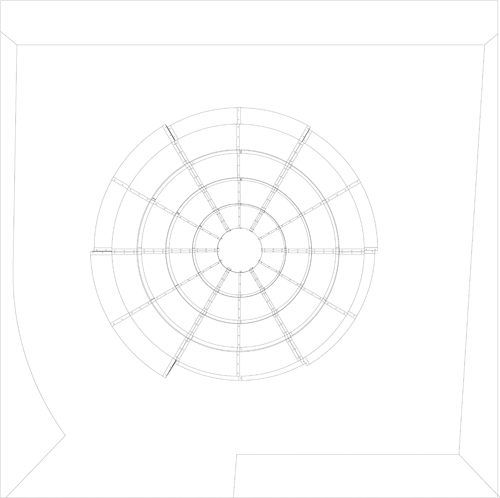
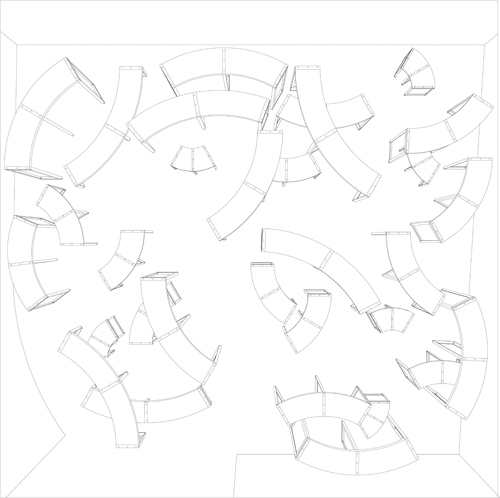
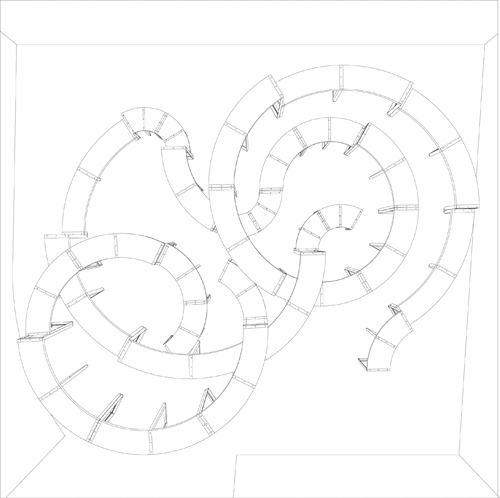
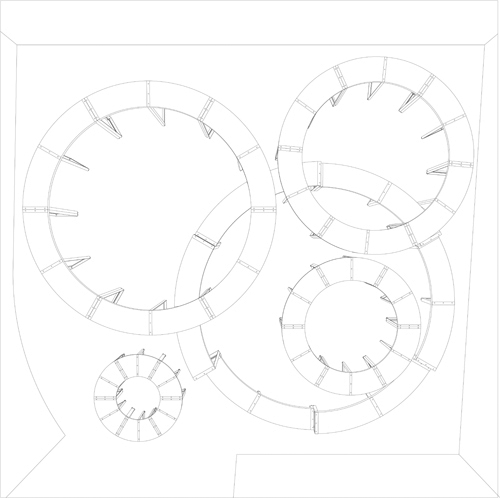

Furnishing Positions
Furnishing Positions is a serial publication that focuses on the paradoxical nature of public space. Its standard form is an 18”x18” broadsheet, consisting of an artist’s project on one side and a text on the other. It will be published once every two weeks for three months, starting September 15, 2014, with each issue focusing on a specific paradox. As a serial, each issue builds on earlier editions. As each issue is published, it will be hung and made available for free in the Blackwood Gallery, posted to the gallery’s website, postered in public sites, and circulated electronically. As the exhibition progresses these broadsheets will accumulate, generating and animating conversations in the space.
Issue 01, 15/09/2014
Abbas Akhavan / Kanishka Goonewardena
Affinity / Disagreement: What draws people to public space?
Issue 02, 29/09/2014
Dylan Miner / cheyanne turions
Representation / Presentation: Is public space made by government or citizens?
Issue 03, 13/10/2014
Greig de Peuter / Paige Sarlin
Materiality / Immateriality: Are public spaces physical or virtual?
Issue 04, 27/10/2014
Karen Houle / Kika Thorne
People / Things: Are public spaces only for humans?
Issue 05, 10/11/2014
Eric Cazdyn / Charles Stankievech
Privacy / Publicity: Is private thought the necessary corollary of public space?
Issue 06, 24/11/2014
Mary Lou Lobsinger / Scott Sørli
City / Urbanization: How do public spaces combine to make cities?
On Saturday November 22 from 1 to 6pm the Blackwood Gallery will host a conversation on Furnishing Positions. This hybrid event is part colloquium, part workshop, part performance, and part experiment. It is a support structure for the exchange of ideas. It is also part of Furnishing Positions. This event will assemble the contributors to the Furnishing Positions broadsheet series for conversations on the paradoxes of public space. Moderated by Adrian Blackwell.
For more details, click here.
Eric Cazdyn is Distinguished Professor of Aesthetics and Politics at the University of Toronto (Centre for Comparative Literature and the Department of East Asian Studies), where he teaches courses on critical and cultural theory, psychoanalysis, Marx and Marxism, Deleuze, film and video, architecture, modern literature, and modern Japan. He is the author of the following books: The Already Dead (Duke, 2012), After Globalization (with Imre Szeman, Wiley-Blackwell, 2011), The Flash of Capital: Film and Geopolitics in Japan (Duke, 2002); and editor of Trespasses: Selected Writings of Masao Miyoshi (Duke, 2010) and Disastrous Consequences (South Atlantic Quarterly special issue, 2007). His most recent book, Nothing: Three Inquiries into Buddhism and Critical Theory (with Marcus Boon and Timothy Morton), will be published in 2015 by The University of Chicago Press. Cazdyn is also a filmmaker, and his films have been screened and performed in Japan, Canada, the U.S., Europe, and, most recently, in the U.K. as part of a two-week residency at The Cube Microcinema (Bristol) with Eric Chenaux.
Greig de Peuter is Assistant Professor in the Department of Communication Studies at Wilfrid Laurier University. He researches the contested political economy of media and cultural production, with an emphasis on work, labour, and employment. He is currently collaborating with Enda Brophy and Nicole Cohen on a multi-country study of precarious labour politics in creative industries. His most recent book, co-authored with Nick Dyer-Witheford, is Games of Empire: Global Capitalism and Video Games (University of Minnesota Press, 2009). His writing has appeared in The Fibreculture Journal, Journal of Communication Inquiry, Journal of Cultural Economy, and several anthologies. His article with Cohen and Brophy, “Interns, Unite! (You Have Nothing to Lose—Literally),” received the 2013 Canadian Association of Journalists/Communication Workers of America—Canada Award for Labour Reporting. He has been active in collectively run autonomous education and curatorial projects, including the Toronto School of Creativity & Inquiry (2005-2010), and, currently, Letters & Handshakes.
Kanishka Goonewardena was trained as an architect in Sri Lanka and now teaches critical theory and urban design at the University of Toronto. His writings have focused on the relations between space and ideology, imperialism and colonialism, and Marxist thought. He has been a visiting professor at the Freie Universität (2009) and the Technische Universität Berlin (2013-2014) and is a co-editor of Space, Difference, Everyday Life: Reading Henri Lefebvre (New York: Routledge, 2008).
Karen Houle is an Associate Professor of Philosophy at the University of Guelph, and adjunct graduate faculty in the School of Fine Art and Music. Her areas of specialization are political theory, ethics, environmental philosophy and feminist thought. She co-edited (with Jim Vernon) Hegel and Deleuze: Together Again for the First Time (Northwestern, 2013). Her monograph, Responsibility, Complexity and Abortion: Toward a New Image of Ethical Thought (Lexington Books, 2013) came out at the end of last year. She is the translator of a book on improvisation (forthcoming, PS Guelph, September 2014) called Lê Quan Ninh: Abécédaire d'une expérience. She has published numerous academic and non-academic articles on topics ranging from animal tracking to Foucault, from watershed ecology to Derrida, from canoe flotillas to Irigaray, from rape to Steve Reich. She is also the author of two books of poetry: Ballast (House of Anansi, 2001) and During (Gaspereau, 2008). In the Fall 2014 she will be the inaugural Eastern Comma Writer-in-Residence at North House, rare.
Mary Lou Lobsinger’s writing and research focus on the history and theory of contemporary architecture and urbanism. Lobsinger’s publications can be found in Grey Room, Werk, Daidalos, Journal of Architectural Education, Thresholds, Architecture+Ideas, Scapegoat, Transmissions,and in various anthologies such as A Second Modernism: MIT, Architecture and the “Technosocial” Moment, Atomic Dwelling: Anxiety, Domesticity, and Postwar Architecture, Architectural Periodicals in the 1960s and ’70s, Import-Export: Postwar Modernism in an Expanding World, 1945-1975, Le Città visibili, Concrete Toronto, Italian Cityscapes: Culture and Urban Change, and Anxious Modernism: Experimentation in Postwar Architectural Culture. She has two current book projects, the completed Realist Impulse (on postwar Italian architectural discourse), and one entitled Neo-avant-gardism and the Politics of Post-materialism. Lobsinger is also completing a video project presently titled Urban Economic Motor. She is Associate Professor of History and Theory of Architecture at the University of Toronto’s John H. Daniels Faculty of Architecture, Landscape, and Design.
Dylan Miner (Métis) is Associate Professor at Michigan State University, where he coordinates a new Indigenous Contemporary Art Initiative. He holds a PhD from The University of New Mexico and has published more than fifty journal articles, book chapters, critical essays, and encyclopedia entries. In 2010, he was awarded an Artist Leadership Fellowship from the National Museum of the American Indian (Smithsonian Institution). Since 2010, he has been featured in more than thirteen solo exhibitions and been artist-in-residence at institutions such as the School of the Art Institute of Chicago, École supérieure des beaux-arts in Nantes, the Klondike Institute of Art and Culture, Rabbit Island, Santa Fe Art Institute, and various universities. His artwork has been the subject of articles or reviewed in publications including ARTnews, Canadian Art, c magazine, Indian Country Today, First American Art Magazine, The Globe and Mail, The Guardian, Måg Magazine (Norway), and The Chicago Sun-Times, among others.
Paige Sarlin is an artist, scholar, and political activist. She holds a PhD in Modern Culture and Media from Brown University and an MFA in Film/Video/New Media from the School of the Art Institute of Chicago. Her feature-length documentary film, The Last Slide Projector, premiered at the Rotterdam International Film Festival in 2007. From 1999 to 2010, she was an active participant in 16Beaver Group in New York City, a platform for the discussion of the intersection of art and politics. Her artwork has been exhibited internationally, and her writings have been published in October, Re-Thinking Marxism, Reviews in Cultural Theory, The Journal of Aesthetics and Protest, Scapegoat, and Framework: A Journal of Film and Culture. She is at work on a book-length manuscript entitled Interview-Work: The Genealogy of a Media Form. She is an Assistant Professor in the Department of Media Study at University at Buffalo, SUNY.
Scott Sørli’s trans-disciplinary practice concerns itself with moments when form and matter engage the economic and political forces that produce the city. He is co-founder of convenience, a window gallery that provides an opening for art that engages, experiments, and takes risks within the architectural, urban, and civic realms. He is also chair of Toronto’s peace subcommittee of the Nathan Phillips Square Community Advisory Committee. Sørli has taught architecture at several institutions, most recently in Jakarta, Indonesia; a book and exhibition on the work of the Inundation research studio conducted there will be published in Fall 2014.
Charles Stankievech has lectured, performed and exhibited at such platforms as dOCUMENTA13 (Kassel), Louisiana Museum of Modern Art (Copenhagen), Haus der Kulturen der Welt and the Kunst-Werke ICA (Berlin), the Palais de Tokyo (Paris), and several art and architecture biennales (Venice, Berlin, Santa Fe, and Montreal). His writings range from academic journals for MIT Press to experimental texts for art publications. His images have been published in a range of forums, from NASA publications to WIRED magazine. He has participated in residencies with the Department of National Defence, the Banff Centre for the Arts, and Fieldwork in Marfa, Texas. He was a founding faculty member of the Yukon School of Visual Arts in Dawson City, Canada and is currently Assistant Professor in the John H. Daniels Faculty of Architecture, Landscape, and Design, at the University of Toronto. Since 2011, he has been co-director of the art and theory press K. located in Berlin.
Kika Thorne, artist, filmmaker, and curator, was a co-founder of she/TV; participated in and documented the sculptural protests of the Toronto-based October, February and April Groups; helped found the Anarchist Free Space & Free School in Toronto's Kensington Market; and in her role as curator for VIVO Media Arts Centre helped instigate SAFE ASSEMBLY, a fourteen-day collective program and gathering to express dissent against the effects of the 2010 Winter Olympic Games in Vancouver. Thorne has exhibited extensively, including projects at e-flux, Kino Arsenal, and Forum Expanded, Berlin; Murray Guy, New York; The Apartment, Access, Contemporary Art Gallery and Vancouver Art Gallery, Vancouver; and Pleasure Dome and the Justina M. Barnicke Gallery, Toronto. Her room-sized tensile sculptures were the focus of The WILDcraft, a solo exhibition at the Art Gallery of Windsor. She received her MFA from the University of Victoria, and she is currently working towards a PhD in Studio Practice at York University, Toronto.
cheyanne turions is an independent, Toronto-based curator and writer who holds a degree in Philosophy from the University of British Columbia. Most recently she co-curated (with Kim Simon) the series Canadian Ecstasy with poet and performance artist Ariana Reines at Gallery TPW and reviewed the Kuwait Pavilion at the Venice Biennale of Architecture for C Magazine. She is also the director of No Reading After the Internet (Toronto), and sits on the Board of Directors for the journal Fillip and the Canadian Filmmakers Distribution Centre. She was the Shop Manager/Curator at Art Metropole from 2012-2014 and is now a part of the organization's Lifetime Membership. Currently she is a member of the co-creative team for the Art and Society theme within the Cities for People project.
Generously supported by the Canada Council for the Arts and the Ontario Arts Council.
![]()

Special thanks to:
Installation Team: Michael Beynon, Alexandra Coulson, Brittany Gerow, Asem Harun, Dax Morrison, Kristie Robertson, Paul Selvaraj, Samson Tam, Juliana Zalucky
Fabricators: JD McNicoll Interiors Ltd., The Steelworks Inc.
University Community: Lyn Carter, Robert Fones,
Jane Hutton, Lyla Rye, Jay Wilson and Students of the UTM and Sheridan joint Art & Art History program